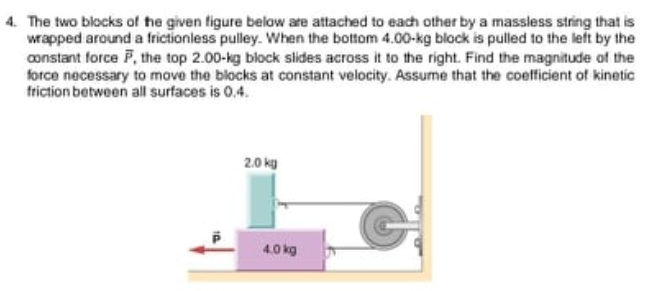The two blocks of the given figure below are attached to each other by a massless string that is wrapped around a frictionless pulley. When the bottom 4.00-kg block is pulled to the left by the constant force F, the top 2.00-kg block slides across it to the right. Find the magnitude of the force necessary to move the blocks at constant velocity. Assume that the coefficient of kinetic friction between all surfaces is 0.4. 2.0 kg 4.0 kg
The two blocks of the given figure below are attached to each other by a massless string that is wrapped around a frictionless pulley. When the bottom 4.00-kg block is pulled to the left by the constant force F, the top 2.00-kg block slides across it to the right. Find the magnitude of the force necessary to move the blocks at constant velocity. Assume that the coefficient of kinetic friction between all surfaces is 0.4. 2.0 kg 4.0 kg
Physics for Scientists and Engineers: Foundations and Connections
1st Edition
ISBN:9781133939146
Author:Katz, Debora M.
Publisher:Katz, Debora M.
Chapter5: Newton's Laws Of Motion
Section: Chapter Questions
Problem 71PQ: A block of ice (m = 15.0 kg) with an attached rope is at rest on a frictionless surface. You pull...
Related questions
Question
The two blocks of the given figure below are attached to each other by a massless string that is wrapped around a frictionless pulley. When the bottom 4.00-kg block is pulled to the left by the constant force P, the top 2.00-kg block slides across it to the right. Find the magnitude of the force necessary to move the blocks at constant velocity. Assume that the coefficient of kinetic friction between all surfaces is 0.4.

Transcribed Image Text:4. The two blocks of he given figure below are attached to each other by a massless string that is
wrapped around a frictionless pulley. When the bottom 4.00-kg block is pulled to the left by the
constant force F, the top 2.00-kg block slides across it to the right. Find the magnitude of the
force necessary to move the blocks at constant velocity. Assume that the coefficient of kinetic
friction between all surfaces is 0.4.
2.0 kg
4.0 kg
Expert Solution
This question has been solved!
Explore an expertly crafted, step-by-step solution for a thorough understanding of key concepts.
This is a popular solution!
Trending now
This is a popular solution!
Step by step
Solved in 3 steps with 1 images

Knowledge Booster
Learn more about
Need a deep-dive on the concept behind this application? Look no further. Learn more about this topic, physics and related others by exploring similar questions and additional content below.Recommended textbooks for you

Physics for Scientists and Engineers: Foundations…
Physics
ISBN:
9781133939146
Author:
Katz, Debora M.
Publisher:
Cengage Learning

Principles of Physics: A Calculus-Based Text
Physics
ISBN:
9781133104261
Author:
Raymond A. Serway, John W. Jewett
Publisher:
Cengage Learning

College Physics
Physics
ISBN:
9781285737027
Author:
Raymond A. Serway, Chris Vuille
Publisher:
Cengage Learning

Physics for Scientists and Engineers: Foundations…
Physics
ISBN:
9781133939146
Author:
Katz, Debora M.
Publisher:
Cengage Learning

Principles of Physics: A Calculus-Based Text
Physics
ISBN:
9781133104261
Author:
Raymond A. Serway, John W. Jewett
Publisher:
Cengage Learning

College Physics
Physics
ISBN:
9781285737027
Author:
Raymond A. Serway, Chris Vuille
Publisher:
Cengage Learning

Physics for Scientists and Engineers, Technology …
Physics
ISBN:
9781305116399
Author:
Raymond A. Serway, John W. Jewett
Publisher:
Cengage Learning

College Physics
Physics
ISBN:
9781938168000
Author:
Paul Peter Urone, Roger Hinrichs
Publisher:
OpenStax College

College Physics
Physics
ISBN:
9781305952300
Author:
Raymond A. Serway, Chris Vuille
Publisher:
Cengage Learning